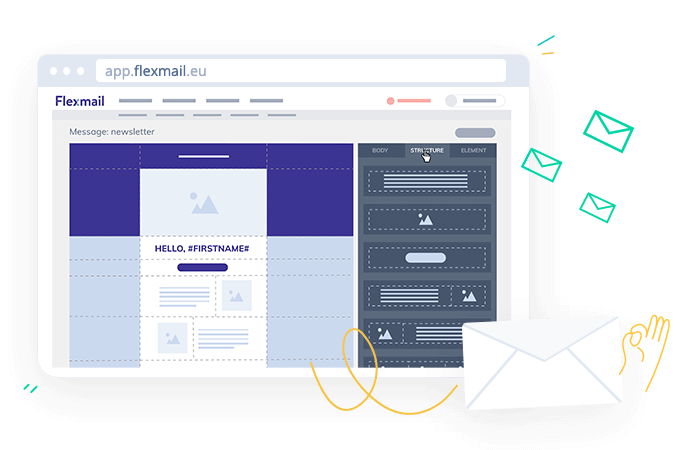
Buy domain name & check availability
All good ideas deserve a domain name
Buy a domain and get everything you need to start your online business.
- Mailbox and e-mail addresses
- Mini website via SiteBuilder Temporary special offer
- 24/7 support in your own language

Why purchase your domain name with Combell?
You get so much more than with our competitors
Your own mailbox and e-mail addresses
Make a professional impression right away thanks to your own mailbox and e-mail address(es) based on your domain name.
Stop using free mailboxes from Telenet, Gmail, etc.


Create a website for free with SiteBuilder
The SiteBuilder you get for free when you purchase your domain allows you to build a basic website in just a few clicks.
More about the free SiteBuilderCreate free newsletters and e-mail campaigns
Buy your domain name from Combell and get a free Flexmail account. This will allow you to create professional e-mails in just a few clicks.
Use Flexmail six months free of charge to mail up to 1,000 contacts.


The reliable support provided by Combell, day and night
Our experienced support team is available day and night to help you in your own language. Even on Christmas Eve!
Are you stuck? Call us, send us a message or ask your question via our chat.
Unlimited subdomains
Create as many subdomains as you need. blog.combell.com. is e.g. a subdomain of www.combell.com.
Redirect visitors to another URL
Use your domain name to redirect visitors to another URL, such as your Facebook page or any other existing websites.
Redirecting e-mails to your mailbox
Automatically forward all e-mails sent to your new e-mail address to your own mailbox. That way, you will have everything in one place.
Money-back guarantee
Are you not satisfied? You can request a full refund up to 3 months after your order.
Find out more about our money-back guaranteeTransfer service
Are your domain and your website hosted elsewhere? We will transfer them to our servers for you free of charge.
Unique deals
As a Combell customer, you get discounts on all kinds of tools such as Flexmail, Leadinfo, etc.
Discover all deals
Do you have any questions or need support about domain names?
Call us free of charge: 0800-8-5678
Buy your domain name with Combell
- Look up your desired domain name
- Select an extension and complete your order
- Done. Your domain name is registered
- Create your free e-mail address and mini-website
Do you already have a domain name?
Transfer it to Combell
Move your web address and benefit from all the free extras such as a free mailbox and e-mail marketing.
Our experienced support team will ensure a flawless move.

Protect your domain name & brand name online
Subscribe to our online trademark protection and we will make sure no one runs off with your online brand name.
We register your brand name online, buy (new) domain names for you (via dropcatching) and thus prevent abuse of your brand name / domain name.

Domain taken? Choose one of the new extensions
Look beyond the classic domain names such as .be, .com or .org. There are now thousands of other extensions possible in all kinds of categories such as hospitality, technology, cities ... This makes it easier to find a suitable domain name.
Frequently asked questions about domain names
What is a good domain name?
A good web domain make it easier for people to find you on the Internet. Finding a good domain name is thus key to your online success.
Some tips:
- Make sure your domain name is easy to remember.
- Avoid confusion over the spelling by registering 'mistyped' alternatives such as kombel.com.
- Incorporate important keywords in your domain name. This will help you rank higher on Google.
How do you check if a domain name is still available?
Come up with a cool name and check its availability using the domain name finder on this page.
- Is the domain name still available? Perfect! Just select it and complete your order before someone else does.
- Is the domain name already taken? Someone else has unfortunately already bought it before you had a chance to do it yourself. In this case, you can always select an alternative extension that is still available or you can try to contact the owner of the domain name that is already taken.
Tip: If you really want to order a domain despite the fact that it is already taken, you should first reach an agreement with its current owner. Then order the domain and provide us with the transfer code. This will allow us to register the domain in your name.
What happens when my domain name expires?
Well before the expiry date of your domain name, we will send you a notification via e-mail. You can then choose whether to renew your domain name or let it expire.
- If you let your domain name expire, no costs will be incurred. But your web domain will become available again for others to buy.
- If you decide to renew your domain name, you will remain its owner and will have to pay the normal annual price. If you ever forget to pay on time, do not panic! Most extensions have a quarantine period during which you can still renew your domain name.
Only in exceptional cases do we recommend to let your domain name expire. Because that would allow someone else to impersonate your company and tarnish your reputation. Click here to learn more about the procedure for expired domain names
What is a domain name?
However, using these numbers is not very user-friendly; it is much easier for you to remember Combell.com than these numbers. And there is another downside to using numbers: if you ever need to migrate the website to a new server, it will probably have a new IP address. Using domain names instead of numbers makes things a lot easier, because the domain name remains the same, even if you change the underlying numerical address.
What is the Domain Name System (DNS)?
What is a TLD?
What types of TLDs are there?
In gTLDs, the extension consists, by convention, of a series of minimum 3 letters, such as .COM, .NET, .ORG, etc.
In ccTLDs, the extension consists of the two letters of the country code. Each domain suffix that consists of 2 letters is a ccTLD.
What is a ccTLD?
In a ccTLD, the extension (the last part of the domain name) consists of the two letters of the country code, like .be for Belgium and .nl for the Netherlands. Some country codes also use a Second-Level Domain, like .co.uk for companies and .org.uk for non-profit organisations in the United Kingdom.
.eu is also considered a country code; it indicates that a company addresses the whole of Europe.
What is a gTLD?
Contrary to ccTLDs such as .be for Belgium and .nl for the Netherlands, which indicate local roots, a gTLD has a more international dimension.
A few years ago, it was decided to increase the number of existing gTLDs. This is how new gTLDs became available for specific professions (like .LAW, for example) or geographic locations (like .VLAANDEREN and .GENT).
What is an extension?
What is a domain registrant?
What is a domain registrar?
The registrar must manage the domains according to the guidelines laid down by the domain name registry concerned. A registrar can also work with dealers or resellers.
Combell is an accredited registrar.
What is a domain registry?
This name also refers to the unique organisation that manages this database and oversees the registration of domain names for a specific Top-Level Domain. DNS.be is e.g. the domain name registry for the .be ccTLD, and VeriSign is the domain registry for the .com gTLD.
In the future, Combell, which submitted an application together with the City of Ghent for the new .GENT gTLD, will become the domain name registry for this gTLD.
What is a WHOIS file?
When the registrant applies for or registers a domain name, he/she is required to provide his/her contact details, which are then stored in the WHOIS record. Depending on the gTLD, these details can be summary or comprehensive. The WHOIS record usually contains the following details:
- REGISTRANT or DOMAIN NAME OWNER: the (legal) person that has the right to use the domain name.
- ONSITE: the name of the technical contact of the registrant; this can be the person who built the website, the hosting provider, etc.
- TECHNICAL: the technical contact of the registrar
Why register a domain name?
In addition, having your own domain allows you to have an e-mail address for life, no matter who provides Internet access to your computer. An e-mail address with your own domain is a must for any self-respecting business. After all, you have got to admit that john@bakerstevens.be sounds much better and more professional than user21234@provider.com, right?
Who can register a domain name?
Restrictions will also apply to some new generic Top-Level Domains that will soon be available; a gTLD like .LAW, for instance, will be reserved for companies and individuals in the legal services industry, etc.
How can I register a domain name?
What criteria must a domain name meet?
A domain name must be available if you want to register it. You can check the availability on our site. If the domain name you had in mind is no longer available exactly as you imagined it (e.g. with the .be ccTLD or the .com gTLD), you can pick one of the other extensions, or slightly change the spelling (my-domain, for instance, instead of mydomain).
The domain name itself (i.e. excluding the extension or suffix, subdomains or the www prefix) should also consist of minimum 2 and maximum 63 characters, which can be letters, numbers and the minus sign. The minus sign can only be used between two letters or numbers, which means it cannot be used as first or last character of the domain name.
Recently, it has been decided to allow accented letters in domain names with the .be ccTLD (like citroën.be or café.be). The following characters are not allowed:
| ß | à | á | â | ã | ó | ô | þ | ü | ú | ð |
| æ | å | ï | ç | è | õ | ö | ÿ | ý | ò | ä |
| œ | ê | ë | ì | í | ø | ù | î | û | ñ | é |
Is a domain name case-sensitive?
Be careful though: this only applies to domains: for paths to HTML files, you have to use the exact spelling.
Example: www.mydomain.be points to the same address as www.MyDomain.be. But those who enter www.mydomain.be/specificfile.htm instead of www.mydomain.be/SpecificFile.htm will get an error message.
How much does a domain name cost?
How long does a registration last?
Why should I register multiple domain names?
You should also think about registering variations of your domain name; in addition to the .be domain name, you should e.g. also register the .com and .net variations. This way, you will be one step ahead of cybersquatters who may register the domain in your name and ask for a lot of money when they resell it to you.
You should also not forget about typosquatters, i.e. people who register a domain with a slightly different spelling than yours (gogle instead of googl, for instance), thus attracting visitors to their website, when all they wanted was to visit your website, but they misspelled your domain name.
Can I resell my domain name?
Is my domain name still available?
Do you want to register a domain name?

Our specialists are available 24/7 to give you free advice about domain names. Feel free to contact Jasper and his colleagues via e-mail or by telephone.
